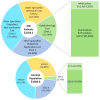Metabolic Syndromes as Important Comorbidities in Patients of Inherited Retinal Degenerations: Experiences from the Nationwide Health Database and a Large Hospital-Based Cohort
- PMID: 33672521
- PMCID: PMC7923804
- DOI: 10.3390/ijerph18042065
Metabolic Syndromes as Important Comorbidities in Patients of Inherited Retinal Degenerations: Experiences from the Nationwide Health Database and a Large Hospital-Based Cohort
Abstract
This study aimed to evaluate the medical and socioeconomic impacts of IRDs using the nationwide health database and a large hospital-based cohort. This retrospective cross-sectional cohort study used data from the nationwide National Health Insurance Research Database (NHIRD). All patients with IRD from January 2012 to December 2016 were selected from the NHIRD and matched with the general population at a ratio of 1:4. All variables, including comorbidities, medications, service utilization, and medical costs, within 1 year from the date of the IRD diagnosis, were analyzed. Disability data were retrieved from the Taiwan Inherited retinal degeneration Project (TIP), a medical center-based database. A total of 4447 and 17,788 subjects from the nationwide database were included in the IRD and control groups, respectively. The Charlson comorbidity index score was higher in the IRD group (0.74:0.52, p < 0.001). Yearly visits to the ophthalmology clinic were more frequent in the IRD group (6.80:1.06, p < 0.001), particularly to tertiary medical centers (p < 0.001). The IRD group showed greater odds ratios (OR) for metabolic syndrome-related comorbidities, including hypertension (OR = 1.18, 95% confidence interval (CI) 1.10 to 1.26) and diabetes (OR = 1.32, 95% CI 1.21 to 1.45), and double the average yearly medical cost (2104.3 vs. 1084.6 USD, p < 0.001) and ten times the yearly ophthalmology cost (369.1 vs. 36.1 USD, p < 0.001). The average disability level was 54.17% for all subjects. This study revealed the large medical and socioeconomic impacts of IRD on not only patients with IRD, but also their family members and the whole society.
Keywords: Charlson comorbidity index; inherited retinal degenerations; metabolic syndrome; socioeconomic impacts.
Conflict of interest statement
The authors declare no conflict of interest.
Figures







Similar articles
-
Comparative Interrupted Time Series Analysis of Long-term Direct Medical Costs in Patients With Hip Fractures and a Matched Cohort: A Large-database Study.Clin Orthop Relat Res. 2022 May 1;480(5):891-902. doi: 10.1097/CORR.0000000000002051. Epub 2021 Nov 22. Clin Orthop Relat Res. 2022. PMID: 34807010 Free PMC article.
-
Current Management of Inherited Retinal Degeneration Patients in Europe: Results of a Multinational Survey by the European Vision Institute Clinical Research Network.Ophthalmic Res. 2021;64(4):622-638. doi: 10.1159/000514540. Epub 2021 Jan 19. Ophthalmic Res. 2021. PMID: 33465765
-
Identification of numerous novel disease-causing variants in patients with inherited retinal diseases, combining careful clinical-functional phenotyping with systematic, broad NGS panel-based genotyping.Mol Vis. 2022 Aug 16;28:203-219. eCollection 2022. Mol Vis. 2022. PMID: 36284670 Free PMC article.
-
The Impact of Inherited Retinal Diseases in the Republic of Ireland (ROI) and the United Kingdom (UK) from a Cost-of-Illness Perspective.Clin Ophthalmol. 2020 Mar 5;14:707-719. doi: 10.2147/OPTH.S241928. eCollection 2020. Clin Ophthalmol. 2020. PMID: 32184557 Free PMC article. Review.
-
Toward an elucidation of the molecular genetics of inherited retinal degenerations.Hum Mol Genet. 2017 Aug 1;26(R1):R2-R11. doi: 10.1093/hmg/ddx185. Hum Mol Genet. 2017. PMID: 28510639 Free PMC article. Review.
Cited by
-
Ocular Characteristics and Genotype-Oriented Disease Spectrum of Alström Syndrome in Taiwan.Transl Vis Sci Technol. 2025 Jun 2;14(6):22. doi: 10.1167/tvst.14.6.22. Transl Vis Sci Technol. 2025. PMID: 40498041 Free PMC article.
References
Publication types
MeSH terms
LinkOut - more resources
Full Text Sources
Other Literature Sources
Medical

